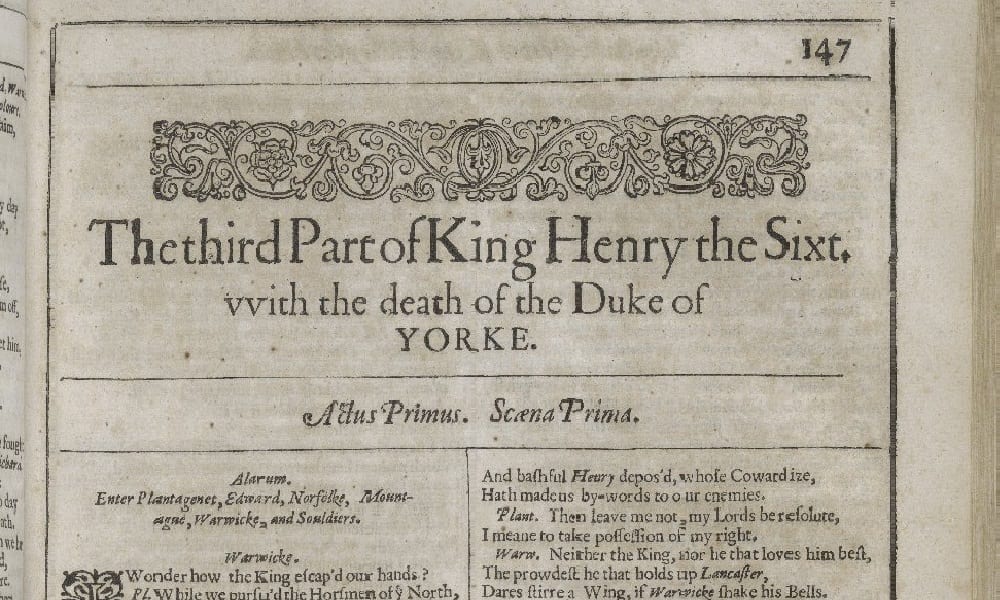Henry VI, Part III appears to start with the conflict being solved. King Henry has regained the semblance of control by naming his rival his heir. Yet, in the swirling mess of allegiances, ambitions and vendettas of the court, this only creates more conflict.
If Part I is a masterwork of intrigue and tension, with those French scenes giving a bit of heroic action, and Part II a slow-burning climb to inevitable battle, Part III is a showcase of the violent realities of civil war. In Henry VI‘s finale, elegant plots are twisted out of shape by revenge and anger.
This focus on revenge has a hint of the more tragic revenge plays of the Elizabethan era, specifically Thomas Kyd’s The Spanish Tragedy. In that case, there is more than just a hint of similarity as Shakespeare appears to have borrowed from Kyd the image of a handkerchief soaked with a child’s blood.
Combining that handkerchief motif with the shocking totality of civil war is the Battle of Towton – of which today is the 560th anniversary. There King Henry sits on a molehill, utterly dejected. It is a molehill much like the one that the Duke of York is described as being killed on, having been handed a handkerchief soaked in his son’s blood.
And as King Henry sits in despair, he recounts having seen a father realise he has killed his son, and a son realise he has killed his father. It is a clear representation of how civil war is a perversion of normal social structures and relationships. Thinking back to Part I, the battles might have scenes of keen pathos, but they are presented as just; a standard part of life which can act as a showcase for bravery. This is totally different, and is as tragic as the death of Juliet or Desdemona.
Part of the skill Shakespeare shows in Henry VI is that this scene is not the end. The audience must withstand the tension for a further few battles and schemes until Henry’s final death, and then like all good pieces of drama with sequels in mind, the seed of Richard Duke of Gloucester’s plotting is revealed through two final asides. So it is not surprising that one of the most frequent ways in which Part III is used is as an addition to the start of adaptations of Richard III. The most famous adaptation that does this is Laurence Olivier’s 1955 film. Olivier lifts entire sections of dialogue from Part III for his film, particularly from Act V.
With such adaptations, it is hard to tell how this reflects the way in which Olivier approaches Shakespeare and the historical context, as he is far from the only director to have done this. Using Henry VI, Part 3 to flesh out the start of Richard III goes back as far as the 1911 film by Frank R. Benson. It can also, to a slightly less extent, be seen in the 1995 film, written by and starring Sir Ian McKellen.
This is not the only time the parts are cut about. It can take the form of taking Henry VI as a continuous narrative and splitting it into two plays. However, this sort of cutting and pasting is also done for stylistic reasons rather than just to consolidate three plays into two. A good example of this is the BBC’s An Age of Kings from 1960, which adapted Richard II through to Richard III and gives Henry VI five episodes. The first episode drastically cuts down Henry VI, Part I by removing Joan of Arc and Talbot. Then Part II and Part III are each split into two episodes. This feels rather odd as it removes much of the tension and foreboding violence that those French scenes provide. On the other hand, it is understandable as it shifts the focus more firmly onto the squabbling over the English throne.
A final adaptation that needs mentioning is Shakespeare’s Rugby Wars, staged at the 2001 Toronto Fringe Festival. Directed by Chris Coculuzzi, it reimagines Henry VI and Richard III as a rugby match between the Lancastrians and Yorkists with sports-style commentary by Marlow and Falstaff (why not?) as the match progresses.
Having reviewed all three parts of Henry VI, I think it is fair to say that it is not the best of Shakespeare’s works. When performed or adapted by capable hands however, it is a well-paced, tense and engaging series of plays – especially when taken with Richard III – and should be seen for the thrilling drama it is.
Words by Ed Bedford.
Support The Indiependent
We’re trying to raise £200 a month to help cover our operational costs. This includes our ‘Writer of the Month’ awards, where we recognise the amazing work produced by our contributor team. If you’ve enjoyed reading our site, we’d really appreciate it if you could donate to The Indiependent. Whether you can give £1 or £10, you’d be making a huge difference to our small team.
Image: Folger Shakespeare Library Digital Image Collection
